This morning I felt like reminiscing a little about the old days at Farmington Bay and the Bald Eagles there in winter. All of these images were taken in February of 2009.
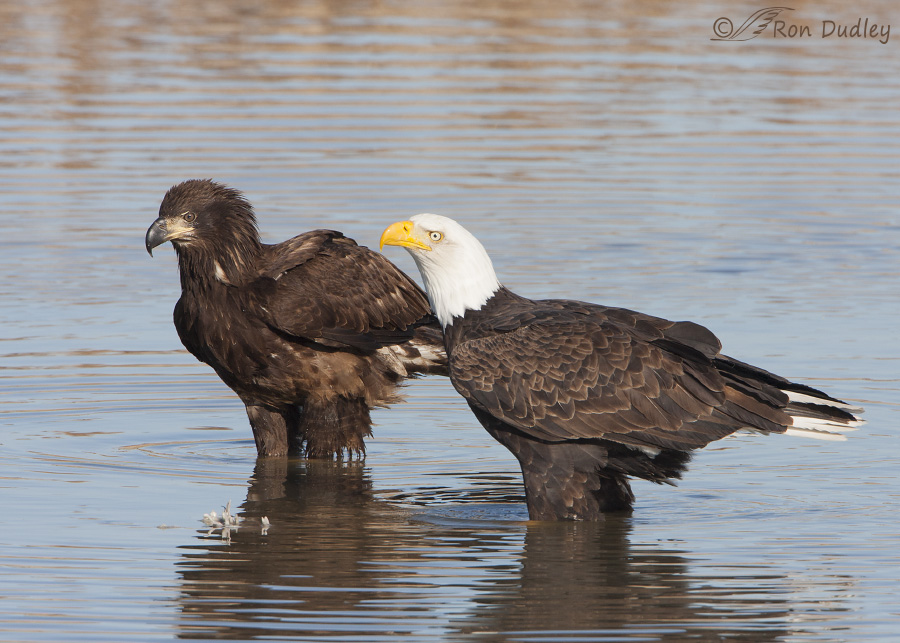
1/800, f/11, ISO 500, Canon 40D, Canon EF 500mm f/4L IS USM + 1.4 tc, not baited, set up or called in
Back then the refuge used to kill invasive carp which eagles learned to take advantage of while they wintered here in northern Utah. In 2009 some of those fish eventually washed down canals from relatively inaccessible areas of the refuge and into some of the shallow ponds, providing a bounty for eagles.
Here a very young immature eagle and an adult are standing next to the mostly submerged carcass of a fish. The adult seemed to be guarding the fish and almost daring the youngster to make an attempt at it so the tension in the air was thick.
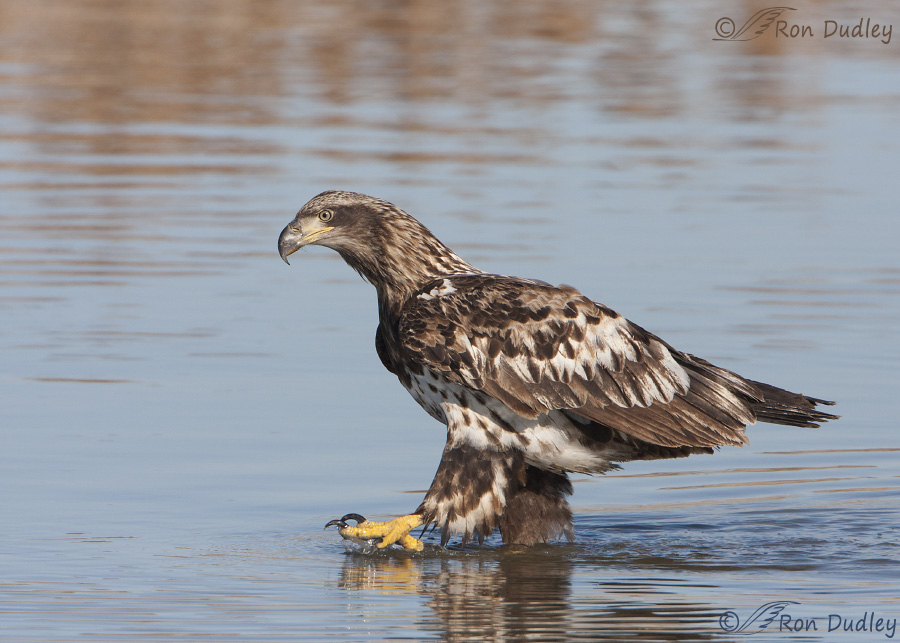
1/2000, f/8, ISO 500, Canon 40D, Canon EF 500mm f/4L IS USM + 1.4 tc, not baited, set up or called in
This interestingly-marked slightly older juvenile was striding through the shallow water with a definite goal in mind.
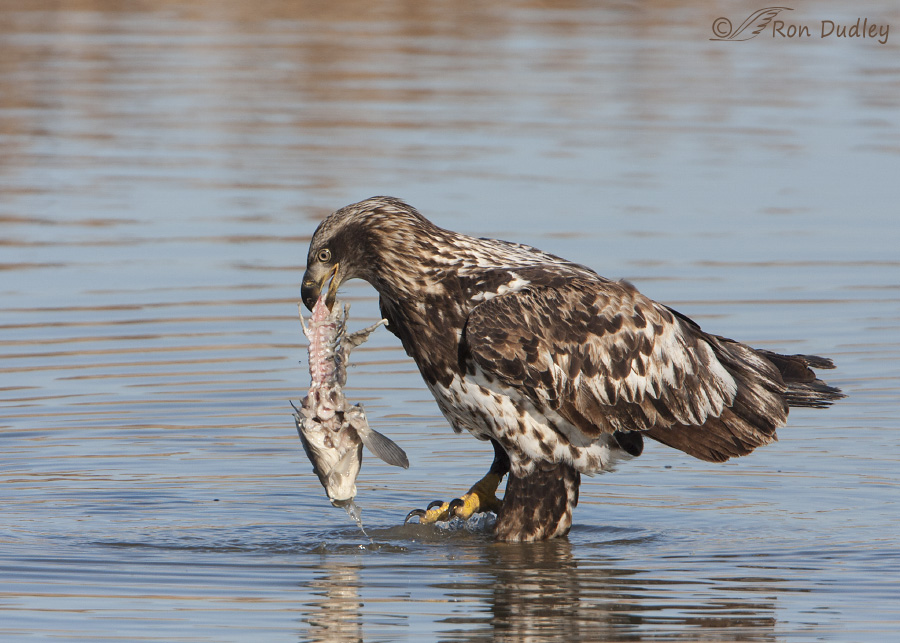
1/2000, f/8, ISO 500, Canon 40D, Canon EF 500mm f/4L IS USM + 1.4 tc, not baited, set up or called in
That goal was the remains of another carp. By this time many of the carcasses had been picked pretty clean.
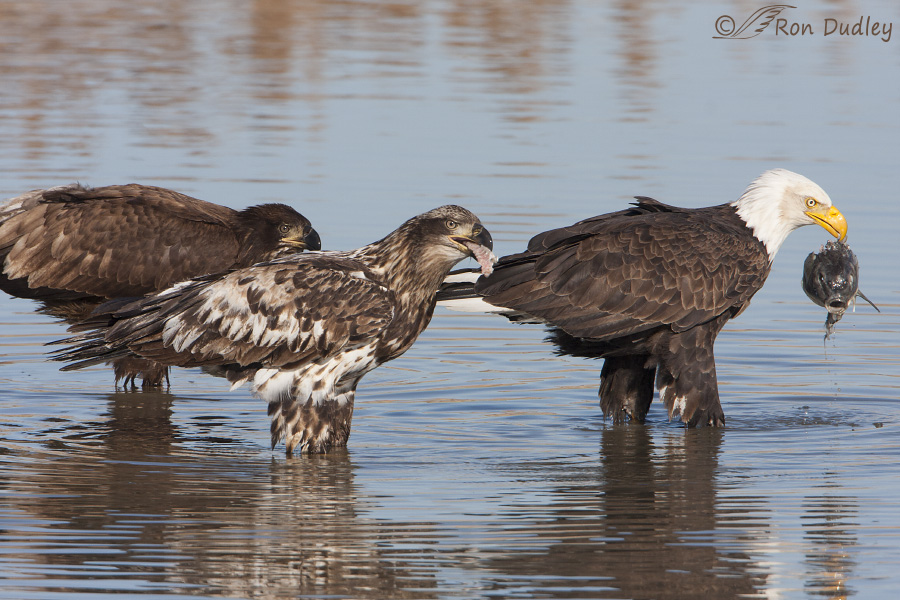
1/1000, f/11, ISO 500, Canon 40D, Canon EF 500mm f/4L IS USM + 1.4 tc, not baited, set up or called in
At the time I was still a relatively inexperienced bird photographer and in all the excitement I sometimes didn’t have the presence of mind to remove my teleconverter when multiple birds were close. In this image the result was a cut off tail (the photo is full frame) but I still enjoy the image for its good look at eagles of three different ages and the fish head carried by the adult. The older bird wasn’t in the mood to share so…
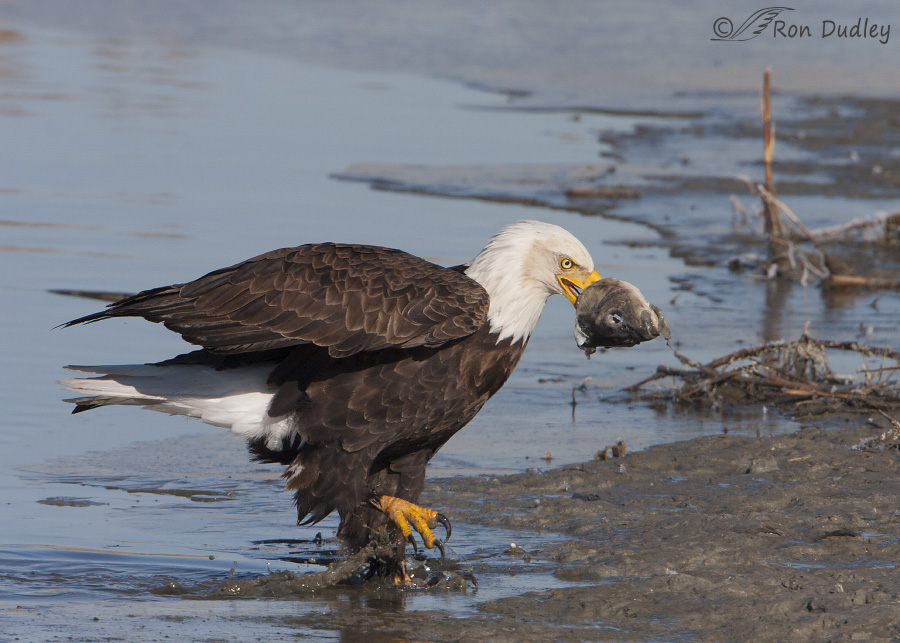
1/1250, f/11, ISO 500, Canon 40D, Canon EF 500mm f/4L IS USM + 1.4 tc, not baited, set up or called in
it carried the head to a more isolated spot before attempting to find something edible on it.
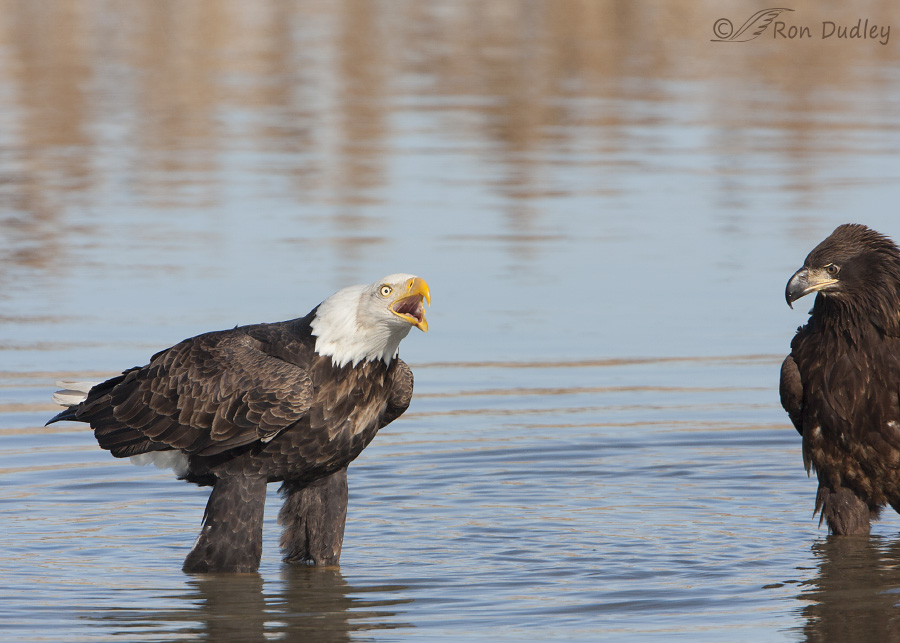
1/1600, f/8, ISO 500, Canon 40D, Canon EF 500mm f/4L IS USM + 1.4 tc, not baited, set up or called in
Eagles being eagles there was often a lot of tension with so many birds vying for limited food. Here an adult guarding a fish in its talons that we can’t see is screaming a warning at a juvenile that approached too closely.
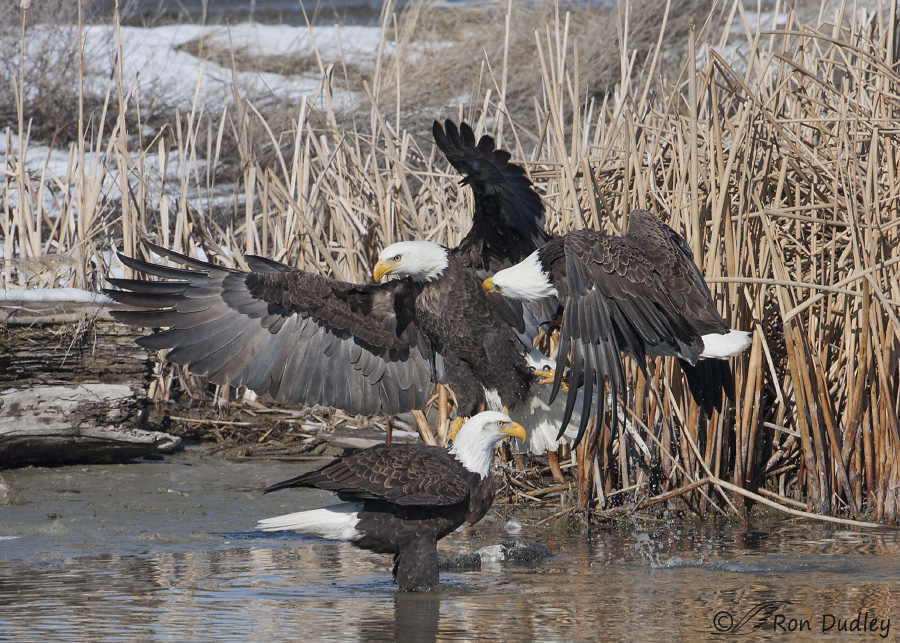
1/2500, f/8, ISO 500, Canon 40D, Canon EF 500mm f/4L IS USM, not baited, set up or called in
Fights often broke out even when they didn’t seem to be over fish.
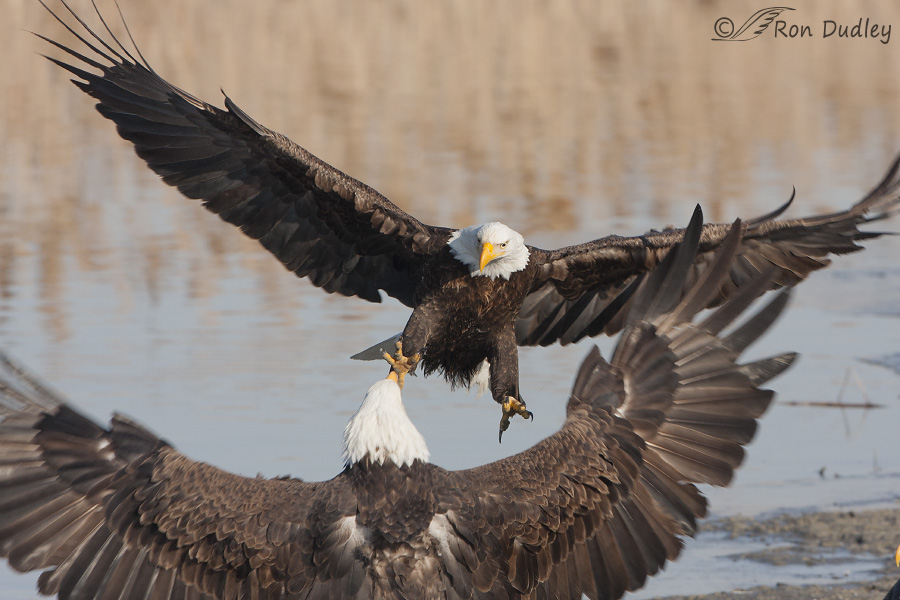
1/640, f/11, ISO 500, Canon 40D, Canon EF 500mm f/4L IS USM, not baited, set up or called in
And sometimes those skirmishes were pretty intense. I sure wish I’d removed my teleconverter for many of those shots.
Those more innocent days are over. In recent years several developments have altered the eagle situation at Farmington. Those developments include:
- as word spread about the eagle viewing opportunities hordes of bird lovers and photographers began clogging the roads in February so the experience became less enjoyable
- significant numbers of photographers began baiting the eagles and Northern Harriers by moving dead fish or ducks (or even store-bought chickens) to more photogenic locations. The baiting situation became so bad that I mostly stopped going to Farmington in February because one often couldn’t tell if you were photographing baited birds or not.
- the state began hauling in truck-loads of dead carp from Utah Lake and dumping them in an attempt to attract even more eagles. Bald Eagles at Farmington had become a nationally known phenomenon that the State of Utah tried to promote – to the point that Governor Herbert encouraged department heads to do everything they could to insure that “Eagle Day” was a huge success.
- then, several years ago, eagles in northern Utah began to die by the dozens. Eventually it was discovered that it was West Nile Virus that was killing them so the fish kill was stopped and they no longer haul truck loads of carp to the refuge for fear that the virus would spread more easily when eagles congregate in large numbers.
So for the last two years eagles at Farmington have been relatively few and far between and most of them stay much further out on the refuge where folks can’t get a good look at them.
Maybe it’s for the best but I must admit that I miss the old days at Farmington – before baiting became such a problem and before they started dumping fish at the refuge.
Ron


Wonderful shots Ron! I can’t even imagine how exciting it would be to see this many Eagles at one time!
Charlotte
Exciting it was, Charlotte.
Eagles are fascinating to watch, especially, as you mentioned, when you get too many in too tight an area. Thanks for the great behavioral descriptions. I hope you’re able to find a new location for viewing and photographing eagles, one that doesn’t become over developed as a result, though that always seems to be the way given time.
“that always seems to be the way given time”
Sadly, you’re right about that, Todd.
I have been scrolling up and down in complete delight and awe. Love the photos, and the intimate glimpses into ‘family life’, which as Laura says is very familiar.
Eagle Day? Making a profit out of them? (And accidentally killing the goose which laid those golden eggs?) Hiss and Spit. And repeat. Loudly.
“Making a profit out of them? ”
Not directly, EC. I think the original purpose of Eagle Day was an admirable one – to promote awareness of eagles and nature in general. But IMO the eagle spectacle at Farmington became so well known that higher-ups began to see it as a state attraction and I believe they went too far when they started hauling in truck loads of carp.
Regardless of the original purpose, the higher ups CERTAINLY saw a profit. And, as I said, hiss and spit.
Hissing and spitting with you EC!
Thank you, Ron, for the historical perspective. Aside from what I consider outstanding photographs, I really enjoy the behavioral documentary! After all, that’s what keeps me slogging through the mud and weeds as often as possible!
Thanks very much, Wally. I’m glad you appreciate behaviors as much as I do.
I remember you posting something about dying Eagles, but didn’t realize it was caused by the WNV. I’m glad the fish dumps ceased because of that. It’s too bad you don’t get to see as many Bald Eagles, but I’m glad that their safety is being considered. I really like these photos, TC issues aside, because even though I’ve seen some Bald Eagles up close, I’ve never had the opportunity to see behaviors like these.
Susan, it took them a long time to figure out what was killing the eagles but eventually WNV was confirmed to be the culprit.
I remember your concern about those die offs all too well! A VERY mystifying, sad, scary time….These are wonderful shots, showing the marking and coloration of the “dirty birds”( juveniles) and the snatch,grab and steal behaviour that’s typical of eagles. My favorite eagles are the Goldens, who, for the most part, provide their own food….we see a lot of Bald eagles in the winter, attracted by fish stunned by Indian Point nuclear power plant. Probably only a matter of time before fish aren’t the only thing stunned by it. The eye color on this young bird are surprisingly light. I would expect darker ones from a young bird…
“Probably only a matter of time before fish aren’t the only thing stunned by it”
That’s always an ominous possibility, isn’t it, Patty?
Hi Patty,
Are you talking about the bird in the 2nd and 3rd photo and the “other (I think)” bird in the 4th photo? My guess is that eagles’ eye lighten up before their feathers but my 8 x 42 binoculars can’t show the details in Ron’s TC.
Thanks for the post Ron. Great images (from yesteryear). I was disappointed to learn that the eagle population during February is not what it used to be. Eagles are on my bucket list and i was planning on coming up there this winter to try my hand with them but your comments seem to indicate it might not be as productive as I had hoped. What would be your suggestion?
It’s likely to not be very productive, Frank. I anticipate (though I don’t know it for fact) that there won’t be either a fish kill or fish hauled in to Farmington this winter.
Thanks Ron. Guess I will have to fill my bucket with Eagles at some other location. Sounds like Alaska might be in the cards from what I understand, Any other suggestions in the western lower 48 where they might congregate? Do appreciate your posts!
I don’t have experience with any other places like that, Frank.
Eagles congregate near the open water around Sauk City WI and the open parts of the Wisconsin River and upper Mississippi in January and February. Sauk City has an Eagle Days weekend celebration but that would be the most crowded conditions for photographing or watching bald eagles. You would need to shoot from your vehicle at the dams sites near Sauk City at all times.
I think bald eagles congregate near Bellingham, WA in the western US but I have never experienced that.
I love this series of pictures. I am a huge bald eagle fan. I was glued to one of the live eagle cams not long ago and watched the laying of the eggs, the chicks emerge from the eggs and the wonderful parenting that occurred afterward. These photos brought back such good memories. We will be leaving next week for a month long trip to an area where these beauties do well. I’m hoping to sit by a river and watch them.
Thanks for the great shots.
I wish you luck with the eagles on your trip, Carol!
GREAT series, Ron! They are beautiful birds. “Human’s” sure have to get in and muck things up when the see an opportunity for profit and my vocabulary for those baiting is not socially acceptable so I will refrain! 🙂 Thx for sharing the photo’s and the commentary!
Agreed, Judy, I have difficulty confining myself to “socially acceptable” terminology here on my blog when I’m talking about those who bait.
There is no “socially acceptable” way to talk about folks who bait. The word that comes to mind for me is scum! Then a stream of other non-socially acceptable words follow.
OK, here’s my string of Oh WOW superlatives, ridiculously redundant 🙂
I just LOVE, LOVE, LOVE the behavioral insights even though I’m not overly fond of bald eagles (sorry, but I have a thing for goldens–LOL!). Just WOW! The plumage of the older juvenile is fascinating, making me want to see what that kiddo looked like as an adult! Are there leucistic bald eagles? Probably, but that bit of knowledge hasn’t come to me yet. And again, we see family relationships, parental interactions (much like ours) and overall real communication, familial and otherwise. Personally, I don’t give a flip that you neglected to remove the teleconverter (whatever that is–I’m a photography luddite) because what you’ve got is simply spectacular (there we go with the superlatives again!). I’m so far beyond grateful that you routinely share windows into their everyday lives. These intimate looks into their lives is fascinating.
On the issue of baiting, there’s certainly the downside, both for you and the eagles, however, if it gets rid of the bulk of humanity disturbing their peace, so be it. It seems all I do these days is shake my head in amazement at the level of sheer stupidity among humans combined with a lack of ethics, personal integrity and an ability to perceive life from the perspective of the wildlife involved. And if the risk of WNV is lessened in the bargain, that’s a good thing.
“Are there leucistic bald eagles?”
I imagine there are, Laura, but I’ve never seen one that I know of.
Oh Wow Love Love Love Thanks for the pictures I watch the eagle cams in Iowa and Florida.
Thank you, Trudy.